ISO Certified Managed SOC UAE: A Complete Guide to Secure Your Business

Articles ISO Certified Managed SOC UAE: A Complete Guide to Secure Your Business Articles ISO Certified Managed SOC UAE: A Complete Guide to Secure Your Business Articles June 13, 2025 Let’s face it—cyber threats aren’t going anywhere. If anything, they’re getting more sophisticated by the day. If you’re running a business in the UAE, you’ve probably heard about Security Operations Centers (SOC) and ISO certifications like ISO 27001 and ISO 27701. But what does it mean to have an ISO certified managed SOC in the UAE? Why does it matter? And how do these certifications actually help protect your business? What Is a Managed SOC? A Security Operations Center (SOC) is like your business’s cyber command center. It monitors, detects, investigates, and responds to cybersecurity incidents 24/7. When this is “managed,” it means a third-party expert team handles it for you—so you get top-tier protection without building your own SOC from scratch. Why UAE Businesses Need a Managed SOC Running a business in the UAE means dealing with strict regulations, fast digital transformation, and increasing cyber risks. A managed SOC helps by: Monitoring your systems round the clock Catching threats before they cause harm Meeting compliance standards like ISO 27001 and ISO 27701 Saving costs on in-house infrastructure and personnel What Does ISO Certification Mean for a SOC? Getting ISO certified means your SOC meets globally recognized standards for information security. It’s not just a badge—it proves your security posture is strong and trustworthy. ISO 27001: Focuses on information security management systems (ISMS) ISO 27701: Extends ISO 27001 to include data privacy management Benefits of an ISO Certified Managed SOC in the UAE Here’s why businesses are choosing certified managed SOCs: Credibility: You show partners and customers you’re serious about security. Compliance: Easily meet local and international regulatory requirements. Risk Reduction: Identify and mitigate threats before they become disasters. Operational Efficiency: Let experts handle cybersecurity while you focus on growth. Understanding ISO 27001 SOC as a Service in UAE ISO 27001 compliance ensures your SOC uses best practices to secure data, handle risks, and maintain confidentiality. It includes: Security policies Risk assessments Business continuity planning Access control mechanisms In a managed SOC, these practices are delivered to you “as a service”—meaning your provider handles it all. ISO 27701 SOC as a Service in UAE ISO 27701 is the privacy add-on to ISO 27001. It focuses on how personal data is collected, stored, and used. For industries dealing with sensitive customer data—think healthcare, finance, or e-commerce—this is crucial. Key Features of an ISO Certified Managed SOC 24/7 Threat Monitoring Incident Detection & Response Real-Time Alerts & Reporting Threat Intelligence Integration Regular Audits & Compliance Checks How ISO Certified SOC Providers Operate in UAE Providers usually follow this process: Initial risk assessment Customized security strategy 24/7 system monitoring Real-time response to threats Monthly compliance reports Challenges Solved by an ISO Certified SOC Insider threats Malware & ransomware Phishing attacks Compliance gaps Data breaches How to Choose the Right SOC Provider in the UAE Check Certifications: Do they have ISO 27001 and 27701? Ask About Their Tech Stack: Do they use advanced tools like SIEM, SOAR, XDR? Read Client Reviews: Are other UAE businesses happy with their service? Request a Demo: See how their platform works in real-time. Pricing of Managed SOC Services in the UAE Costs vary based on: Size of your business Type of data you handle Number of endpoints Compliance requirements Industries That Benefit Most Banking & Finance Healthcare Retail & E-Commerce Government Real Estate & Property Management Common Myths About ISO Certified SOCs “It’s only for big corporations” — Nope, SMEs need protection too. “It’s too expensive” — The cost of a breach is way higher. “We already have antivirus” — That’s not nearly enough. Future of Managed SOC in UAE With cyber threats growing and data laws tightening, the demand for ISO certified SOCs is only going to increase. UAE’s Vision 2030 includes major digital transformation plans—cybersecurity will be at the heart of it. Conclusion If you’re serious about securing your business in the UAE, investing in an ISO certified managed SOC isn’t just smart—it’s necessary. With ISO 27001 and ISO 27701 compliance, you get top-tier protection, credibility, and peace of mind. So don’t wait for a cyber attack to take action—get proactive and safeguard your business now. FAQ’s ISO Certified Managed SOC UAE What is the main benefit of ISO 27001 for a SOC? It ensures your information security management system is robust, systematic, and globally recognized. Is ISO 27701 required for all businesses in the UAE? Not required, but highly recommended if you handle personal data. What’s the difference between SOC and SOCaaS? SOC is the setup itself; SOCaaS is when it’s delivered as a service by a third-party provider. Can small businesses afford ISO certified SOC services? Yes, many providers offer scalable solutions based on business size. How long does ISO certification take? Usually 3-6 months depending on your current security posture.
ISO Certified Company Services in Dubai, UAE: Your Guide to Compliance and Quality by SNSKIES

Articles ISO Certified Company Services in Dubai, UAE: Your Guide to Compliance and Quality by SNSKIES Articles ISO Certified Company Services in Dubai, UAE: Your Guide to Compliance and Quality by SNSKIES Articles June 11, 2025 In today’s competitive business environment, obtaining ISO certification is a vital step toward demonstrating commitment to quality, efficiency, and international standards. SNSKIES, an ISO certified company operating in the UAE—including Dubai, Abu Dhabi—and across the region, offers expert ISO certification services that provide a proven framework to enhance operational performance, boost customer confidence, and expand market opportunities both locally and globally. Why ISO Certification Matters in the UAE ISO certification confirms that a company adheres to internationally recognized standards covering various aspects such as quality management, information security, environmental responsibility, and privacy protection. Popular standards include ISO 27001 for Information Security Management and ISO 27701 for Privacy Information Management. Achieving these certifications signals a company’s dedication to excellence and continuous improvement. SNSKIES holds ISO 27001:2022 and ISO 27701:2019 certifications, underscoring its commitment to these standards. Businesses in Dubai, Abu Dhabi, and across the UAE pursue ISO certification to: Streamline processes and increase operational efficiency Fulfill regulatory and legal requirements specific to the UAE market Build trust with customers, partners, and stakeholders Access government contracts and international markets ISO Certification Services by SNSKIES in the UAE The demand for ISO certification consultants is rising across industries such as construction, healthcare, IT, manufacturing, and services within the UAE. SNSKIES provides expert consultancy services to assist organizations in navigating the certification process smoothly, minimizing disruptions while ensuring full compliance with local and international standards. Commonly sought ISO standards in the UAE include: ISO 27001 – Information Security Management Systems ISO 27701 – Privacy Information Management The Role of SNSKIES as ISO Consultants in Dubai and Abu Dhabi SNSKIES guides UAE businesses through every phase of certification—from initial assessments and gap analysis to documentation, staff training, internal audits, and final certification audits. Their tailored services ensure a seamless path to certification and ongoing compliance. Key services offered by SNSKIES include: Initial consultation and feasibility studies Comprehensive gap analysis and risk assessments Development and review of documentation Training programs for employees and management Internal audits and pre-certification checks Post-certification support for continuous improvement Benefits of Partnering with SNSKIES for ISO Certification in the UAE Working with SNSKIES offers numerous advantages: Accelerated and efficient certification processes Expertise in international standards and UAE-specific regulations Accurate and thorough documentation preparation Support through surveillance audits and recertification Assurance of compliance with regional legal requirements ISO 27001 and ISO 27701 Certification Process with SNSKIES SNSKIES helps organizations establish robust Information Security Management Systems (ISMS) and Privacy Information Management Systems (PIMS) to protect sensitive data, mitigate risks, and comply with both local and global regulations. Their certification process includes defining objectives, gap analysis, policy development, staff training, implementation of controls, internal audits, certification audits, and ongoing monitoring. ISO Certification Across Key Emirates SNSKIES supports businesses throughout the UAE, including Dubai, Abu Dhabi, Sharjah, Ajman, Ras Al Khaimah, Fujairah, and Al Ain, leveraging strong local presence and global expertise to deliver effective ISO certification services. Conclusion Becoming ISO certified in the UAE through SNSKIES is a mark of quality and reliability that enhances your organization’s reputation, operational excellence, and business opportunities. With SNSKIES’ professional support and structured approach, companies can confidently achieve certification and build a foundation for long-term growth. Choose SNSKIES, a trusted ISO certified company with proven UAE regional experience and industry knowledge, to guide your certification process and deliver customized,
Digital Forensics and Incident Response Certifications
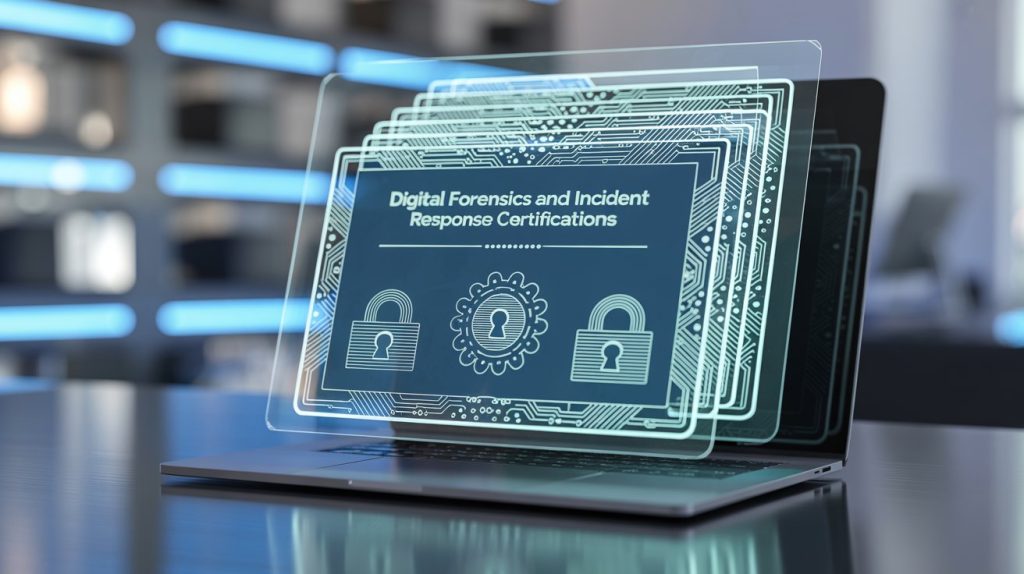
Articles Digital Forensics and Incident Response Certifications Articles Digital Forensics and Incident Response Certifications Articles June 10, 2025 ISO Certified Company for Advanced Cybersecurity & Privacy Compliance SNSKIES is a leading ISO Certified Company, proudly accredited with both ISO 27001:2022 for Information Security Management and ISO 27701:2019 for Privacy Information Management System (PIMS). These globally recognized standards validate our robust cybersecurity infrastructure and privacy-first approach to managing Personally Identifiable Information (PII). Our certification in Digital Forensics and Incident Response (DFIR) highlights our commitment to delivering secure, swift, and strategic responses to cyber incidents, while maintaining full regulatory compliance. Certified Cybersecurity & DFIR Services by SNSKIES As an ISO 27001 certified company, SNSKIES guarantees data integrity, confidentiality, and availability. Complementing this, our ISO 27701 certified company status ensures all PII is handled with utmost care and in alignment with global privacy standards such as GDPR and CCPA. Key Certified Services Include: Managed Security Operations Center (Managed SOC) Digital Forensics & Incident Response (DFIR) Threat Intelligence & Threat Hunting Proactive Incident Detection & Remediation Privacy-Driven Data Security & Governance ISO 27001:2022 – Securing Information Assets The ISO 27001:2022 certification empowers SNSKIES to design and deliver secure IT systems across industries. Our controls prevent unauthorized access, mitigate insider and external threats, and maintain business continuity. Benefits for Clients: Secure infrastructure & data lifecycle Certified incident response systems Advanced monitoring & threat detection Risk management & global compliance ISO 27701:2019 – Protecting Personal Data with PIMS Our ISO 27701 certification validates our Privacy Information Management System (PIMS), ensuring full alignment with data protection laws. SNSKIES helps organizations meet privacy obligations and build customer trust. What Makes SNSKIES a Trusted DFIR & Cybersecurity Partner 1. Global ISO CertificationsDual certification as an ISO 27001 and ISO 27701 certified company assures comprehensive cyber and privacy risk control. 2. Expert Cybersecurity SpecialistsOur DFIR team includes certified forensic analysts, threat hunters, and privacy consultants. 3. Cutting-Edge TechnologyWe utilize AI-driven threat analysis, Zero Trust frameworks, and behavioral detection tools. 4. Industry-Leading ExperienceSNSKIES protects financial, healthcare, education, and government clients across the globe. Conclusion With certified capabilities in Digital Forensics and Incident Response, SNSKIES offers unmatched expertise in threat mitigation, investigation, and privacy protection. Our dual ISO certifications (27001 & 27701) reflect our strategic promise to deliver world-class, regulation-ready cybersecurity services for any industry. Frequently Asked Questions (FAQs) What is the benefit of ISO certification in digital forensics and incident response? It ensures that your DFIR operations follow best practices in information handling, investigation procedures, and legal compliance. Does ISO 27701 help with global data protection regulations? Yes, it supports alignment with GDPR, CCPA, and other regulatory frameworks by embedding privacy into your cybersecurity system. How fast is your incident response service? Our 24/7 Managed SOC enables immediate threat alerts, root cause analysis, and containment action by certified DFIR professionals. Can you support audits and compliance checks? Absolutely. Our certifications and governance frameworks prepare organizations for regulatory scrutiny with full documentation and controls.
SD-WAN Service Providers: Secure, Scalable Networking Solutions
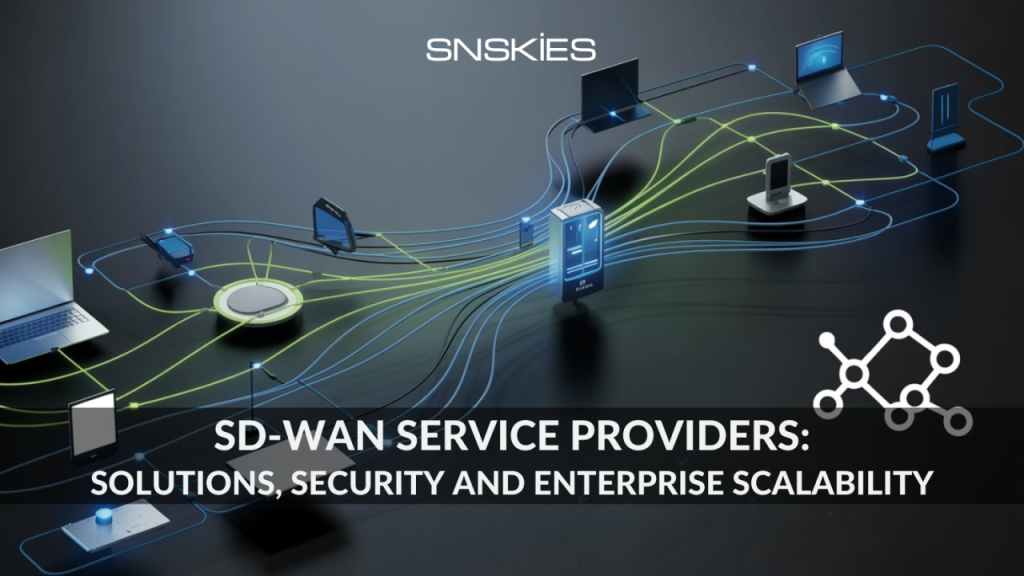
Articles Agentic AI for Security Operations: How SNSKIES Transforms SOC Efficiency in 2025 Articles Agentic AI for Security Operations: How SNSKIES Transforms SOC Efficiency in 2025 Articles May 20, 2025 Understanding SD-WAN and Its Role in Modern Networking SD-WAN (Software-Defined Wide Area Networking) is revolutionizing how businesses connect their networks across branch offices, cloud environments, and data centers. By decoupling network control from physical hardware, SD-WAN service providers offer agile, cost-efficient, and performance-optimized WAN infrastructures. These providers deliver sd wan solutions that support hybrid and multi-cloud environments while improving application delivery and security. What Do SD-WAN Service Providers Offer? SD-WAN service providers enable enterprises to move beyond traditional WANs by utilizing broadband, LTE, and other low-cost links while maintaining enterprise-grade performance and reliability. These providers offer managed or co-managed services, allowing businesses to focus on core operations while network performance, provisioning, and security are handled by experts. Key benefits include: Intelligent traffic routing based on application priority and real-time network conditions Centralized orchestration for network visibility and control Cost reduction by minimizing reliance on legacy MPLS lines Rapid deployment with zero-touch provisioning and automation Seamless integration with cloud and edge infrastructures Essential Features to Look for in SD-WAN Solutions Not all SD-WAN solutions are created equal. Businesses should evaluate providers based on the following essential features: Cloud-native architecture: Support for multi-cloud and hybrid cloud environments with direct cloud on-ramp capabilities. Dynamic path selection: Real-time traffic routing across the best-performing links for optimal application delivery. Centralized management dashboard: Unified control over network policies, performance monitoring, and troubleshooting. Zero-touch provisioning: Quick site deployment with minimal manual intervention, reducing time-to-service. Service-level agreements (SLAs): Guarantees on uptime, latency, and performance to ensure reliability. Integrated Security Within SD-WAN Solutions A critical advantage of modern SD-WAN solutions is the integration of advanced security mechanisms directly into the network fabric. SD-WAN service providers commonly deliver: End-to-end encryption: Secure communication across all links, including public internet. Next-gen firewall capabilities: Built-in firewalls at each edge location to monitor and block threats. Cloud access security: Enforced policies to protect data flowing to and from SaaS and IaaS platforms. Intrusion detection and prevention systems (IDPS): Real-time monitoring of malicious activity across the network. Consistent policy enforcement: Unified security policies across all branch locations and cloud access points. This approach reduces complexity while ensuring that security scales with the network. How SD-WAN Service Providers Empower Scalability and Agility SD-WAN solutions empower businesses to scale efficiently by abstracting network infrastructure into a software layer. This allows enterprises to: Instantly connect new branch locations without manual provisioning Dynamically adjust bandwidth based on demand Deploy remote workforces with secure, high-performance access to cloud applications Respond to outages with automated rerouting and failover By partnering with the right SD-WAN service provider, enterprises gain the agility needed to support digital transformation, global expansion, and evolving business needs. Conclusion: Why Choosing the Right SD-WAN Service Provider Matters Selecting the right SD-WAN service provider is essential for achieving long-term networking success. Businesses should prioritize providers that offer comprehensive SD-WAN solutions, including strong security, cloud integration, centralized control, and real-time analytics. With the right solution in place, organizations can expect reduced costs, improved application performance, and a network infrastructure that’s ready to scale with their future. Recent Post All Posts Articles SD-WAN Service Providers: Secure, Scalable Networking Solutions June 2, 2025/ Converged Infrastructure Services: Benefits, Components & Deployment | SNSKIES May 30, 2025/ Agentic AI for Security Operations: How SNSKIES Transforms SOC Efficiency in 2025 May 20, 2025/ Older Posts
Converged Infrastructure Services: Benefits, Components & Deployment | SNSKIES

Articles Converged Infrastructure Services: Benefits, Components & Deployment | SNSKIES Articles Converged Infrastructure Services: Benefits, Components & Deployment | SNSKIES Articles May 30, 2025 What Are Converged Infrastructure Services? Converged Infrastructure Services bring together servers, storage, networking, and management software into a single, unified platform. Instead of piecing together equipment from different vendors, organizations can deploy these all-in-one solutions to simplify and modernize their data centers. Why Consider Converged Infrastructure? Adopting converged infrastructure offers several compelling benefits for businesses aiming to streamline IT operations: Simplified Management: Centralized tools make it easier to oversee and maintain your environment. Scalable Storage: Effortlessly expand storage capacity as your organization grows. Rapid Provisioning: Deploy new resources in minutes instead of waiting weeks. Seamless Cloud Integration: Transition smoothly into hybrid or private cloud setups. Enhanced Control: Gain complete visibility and governance over your IT assets. Benefits and Challenges Advantages Compatibility: Pre-tested hardware and software eliminate integration headaches. Cost Efficiency: Reduced hardware sprawl leads to lower operational costs. Streamlined Support: Dealing with a single vendor simplifies troubleshooting and maintenance. Challenges Vendor Lock-In: Relying on one provider can limit flexibility for future upgrades. Initial Complexity: Setting up the system may require expertise and careful planning. Core Components of Converged Infrastructure A robust converged infrastructure solution is built on four key elements: Networking: High-speed connections that link all components. Servers: The processing backbone for applications and workloads. Storage: Centralized repositories for data, often using SAN or NAS technologies. Virtualization: Efficiently allocates resources by abstracting hardware from software. Key Service Models Infrastructure as a Service (IaaS): On-demand access to computing and storage resources. Platform as a Service (PaaS): Tools and frameworks for developing and deploying applications. Software as a Service (SaaS): Web-based applications delivered via the cloud. Comparing Infrastructure Models Type Key Features Converged Pre-integrated hardware managed as one system Hyperconverged Software-defined resources clustered across nodes, scalable with commodity hardware Composable Hardware-agnostic resources dynamically allocated via APIs While all three break down traditional IT silos, they differ in flexibility and scalability. Hyperconverged infrastructure operates at the hypervisor level, whereas composable infrastructure allows for granular, API-driven resource management. Deployment Approaches Organizations typically choose between: Reference Architectures: Custom solutions built using validated hardware and software blueprints. Pre-Racked Systems: Factory-assembled, ready-to-deploy solutions shipped directly to your data center. Experience Next-Level Efficiency with SNSKIES Converged infrastructure services are designed to cut through complexity and prepare your organization for the cloud era. By unifying critical IT components, your business can become more agile and responsive—without giving up control. Ready to modernize your data center? Partner with SNSKIES to implement converged infrastructure that’s built for scalability, simplicity, and top-tier performance. Recent Post All Posts Articles Converged Infrastructure Services: Benefits, Components & Deployment | SNSKIES May 30, 2025/ Agentic AI for Security Operations: How SNSKIES Transforms SOC Efficiency in 2025 May 20, 2025/ Secure Your Data with snskies Amid Pakistan’s Escalating Cyber Attack Alerts May 7, 2025/ Older Posts
Agentic AI for Security Operations: How SNSKIES Transforms SOC Efficiency in 2025
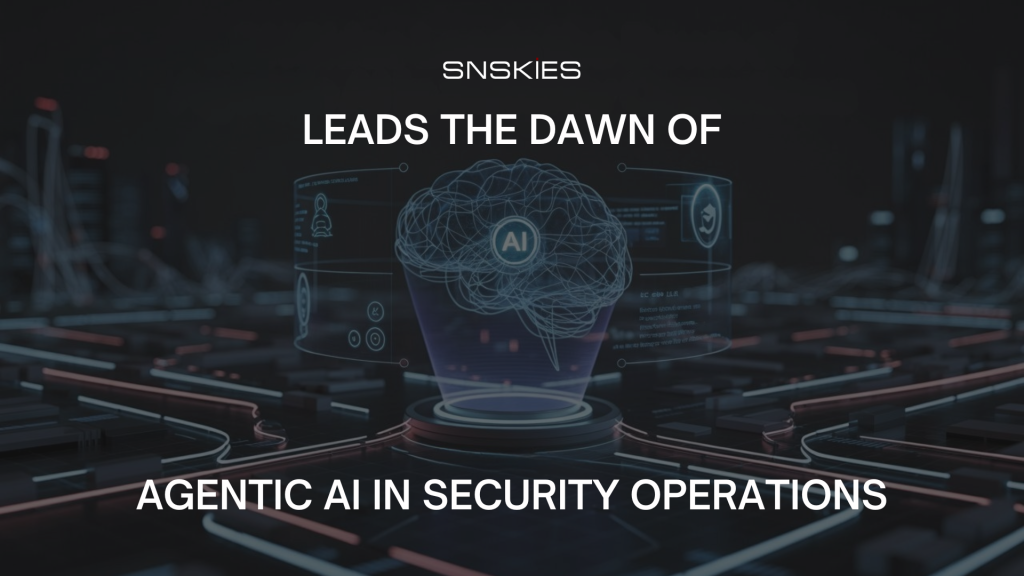
Articles Agentic AI for Security Operations: How SNSKIES Transforms SOC Efficiency in 2025 Articles Agentic AI for Security Operations: How SNSKIES Transforms SOC Efficiency in 2025 Articles May 20, 2025 SNSKIES Leads the Dawn of Agentic AI in Security Operations The relentless pace of cyber threats and the overwhelming volume of security alerts are pushing security teams to their limits. At SNSKIES, we are pioneering the integration of agentic AI into security operations, ushering in a new era where intelligent agents work side-by-side with human analysts to automate repetitive tasks, enhance decision-making, and empower defenders to focus on the most complex and strategic challenges. What Is Agentic AI and Why Does It Matter? Unlike traditional assistive AI, which simply supports human actions, agentic AI at SNSKIES can independently identify, reason, and dynamically execute tasks to achieve security goals—all while keeping human analysts informed and in control. This shift marks a fundamental transformation in how security operations centers (SOC) function, promising exponential gains in efficiency and effectiveness. SNSKIES Agentic SOC: The Future of Security Operations Our vision at SNSKIES is to build an agentic SOC powered by a network of specialized, use-case-driven AI agents. These agents collaborate with human analysts to execute semi-autonomous and autonomous security workflows, drastically reducing manual workloads and elevating the focus to advanced threat investigations and strategic initiatives. Key Functions Automated by SNSKIES Agentic AI Data Management: Ensures data quality and optimizes pipelines for actionable insights. Alert Triage: Prioritizes and escalates alerts, providing transparent audit logs for every decision. Investigation: Gathers evidence, analyzes context, and delivers verdicts on security alerts. Response Automation: Remediates incidents using integrated workflows, such as endpoint isolation. Threat Research & Hunting: Proactively identifies and investigates emerging threats. Malware Analysis: Reverse engineers suspicious files, executes deobfuscation scripts, and summarizes findings. Exposure Management: Monitors for credential leaks, broker activity, and exploitable vulnerabilities. Detection Engineering: Continuously refines detection rules based on evolving threat profiles. The SNSKIES Advantage: Security Data, AI Expertise, and Interoperability SNSKIES leverages a deep reservoir of security data and expertise, advanced AI research, and a robust technology stack to deliver dependable, high-impact security agents. Our modular, scalable architecture allows for rapid development and deployment of new agents, each designed for specific SOC tasks. We champion interoperability through open protocols, enabling seamless collaboration between agents from different developers and platforms. This approach not only boosts autonomy and productivity but also reduces long-term operational costs. Real-World Impact: Efficiency, Transparency, and Collaboration With SNSKIES agentic AI, security teams no longer spend hours on repetitive tasks like writing detection rules or triaging hundreds of daily alerts. Our intelligent agents complete these tasks in seconds, providing clear audit trails and freeing analysts to tackle the threats that truly matter. The result is a more resilient, agile, and proactive security posture for organizations of all sizes. Shaping the Future: SNSKIES SecOps Labs SNSKIES is committed to continuous innovation and collaboration. Our SecOps Labs initiative offers early access to AI pilots, including automated detection engineering, response playbook generation, and natural language data parsing. This collaborative space ensures our solutions evolve to meet real-world security challenges and deliver measurable value to defenders
Secure Your Data with snskies Amid Pakistan’s Escalating Cyber Attack Alerts
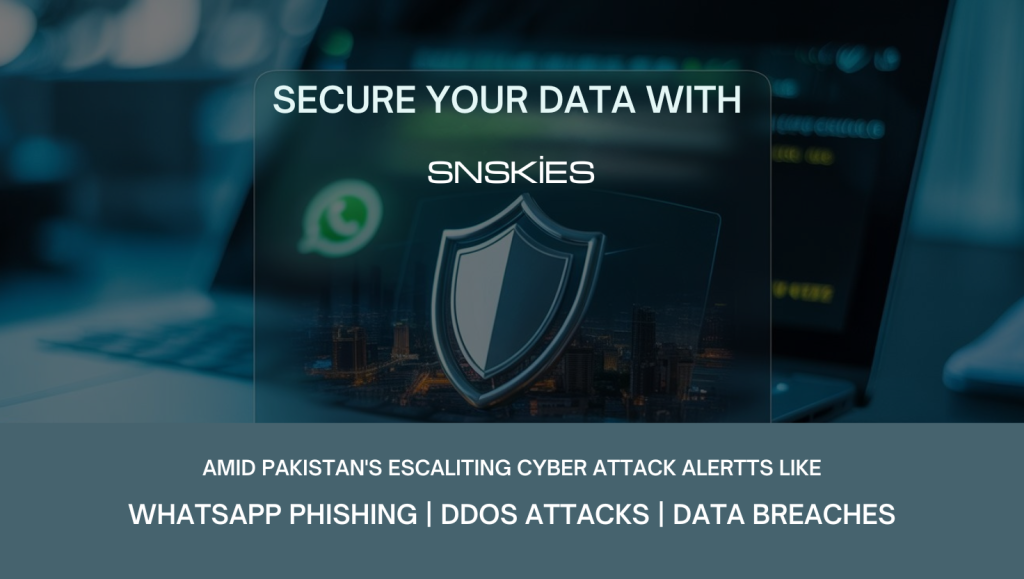
Articles The Evolution of ITCN: How SNSKIES Is Advancing the Future of IT and Telecom in Pakistan at ITCN Asia Lahore 2025 Articles The Evolution of ITCN: How SNSKIES Is Advancing the Future of IT and Telecom in Pakistan at ITCN Asia Lahore 2025 Articles April 22, 2025 Navigating Cyber Threats in Pakistan: snskies’s Commitment to Your Security Following India’s Operation Sindoor missile strikes in May 2025, Pakistan faces a surge in cyber threats, including phishing scams, ransomware, and data breaches. For individuals and businesses operating digitally, security has become non-negotiable. At snskies, we are committed to protecting your data through advanced cybersecurity protocols tailored for today’s threat environment. Snskies’s Cybersecurity Framework: Defending Your Digital Presence End-to-End Encryption & PCI DSS Compliance Secure Transactions: All financial and personal data handled through snskies is protected using PCI DSS-compliant encryption protocols. Data Privacy: Information is encrypted both during transmission and while stored, in full alignment with global data protection standards. Robust DDoS Protection for Platform Stability Cloudflare Shielding: Our integration with Cloudflare defends against Distributed Denial of Service (DDoS) attacks, ensuring uninterrupted access to our services. Geo-Redundant Infrastructure: Our globally distributed server network minimizes downtime and enhances platform resilience. Combating WhatsApp Phishing: Stay Alert with snskies Cybercriminals increasingly use WhatsApp to impersonate businesses and steal data. Common tactics include: Fake Discount Messages: “Limited someone’s deals” that link to malicious websites. Urgent Payment Requests: Messages requesting immediate action through unsafe payment gateways. snskies Response Measures: Real-Time Threat Alerts: Users receive timely warnings via email and SMS about ongoing scam tactics. Official Contact Only: All communications are verified through our secure platform and official messaging channels. Case Example: In April 2025, a phishing campaign targeted users with fake “account upgrade” offers. snskies quickly intervened, issuing platform-wide alerts and blocking phishing domains, successfully preventing user data compromise. Proactive Security Practices for Individuals and Businesses For Individuals: Verify URLs: Confirm web addresses Enable MFA: Strengthen account security with two-step authentication. Avoid Untrusted Downloads: Only access snskies tools from official sources. Report Phishing: Forward suspicious content to our support or Pakistan Telecommunication Authority at 0800-25625. For Business Clients: Phishing Awareness Training: Employees undergo quarterly training simulations using tools. Vendor Security Audits: Regular third-party risk assessments ensure that partners maintain cybersecurity compliance. Snskies’s Continuous Commitment to Cyber Resilience Ongoing Enhancements: 24/7 Threat Monitoring: Using advanced tools like Splunk, we monitor traffic for anomalies and potential breaches in real time. Regular Penetration Testing: We actively test our systems to identify and patch vulnerabilities before attackers exploit them. Optional Cyber Insurance Our CyberSafe Protection Plan helps mitigate financial loss in the event of online fraud or service disruption caused by cyberattacks. Conclusion: Trust snskies to Secure Your Digital World In an era where cybersecurity threats mirror real-world tensions, snskies is your trusted digital guardian. Through robust security protocols, awareness campaigns, and cutting-edge infrastructure, we protect your data from Pakistan’s evolving cyber risks. Act with Confidence: Secure your accounts and data today at snskies. Recent Post All Posts Articles Secure Your Data with snskies Amid Pakistan’s Escalating Cyber Attack Alerts May 7, 2025/ Top 5 Cybersecurity Trends to Watch at ITCN ASIA 2025 – Insights from SNSKIES April 29, 2025/ The Evolution of ITCN: How SNSKIES Is Advancing the Future of IT and Telecom in Pakistan at ITCN Asia Lahore… April 22, 2025/ Older Posts
Top 5 Cybersecurity Trends to Watch at ITCN ASIA 2025 – Insights from SNSKIES
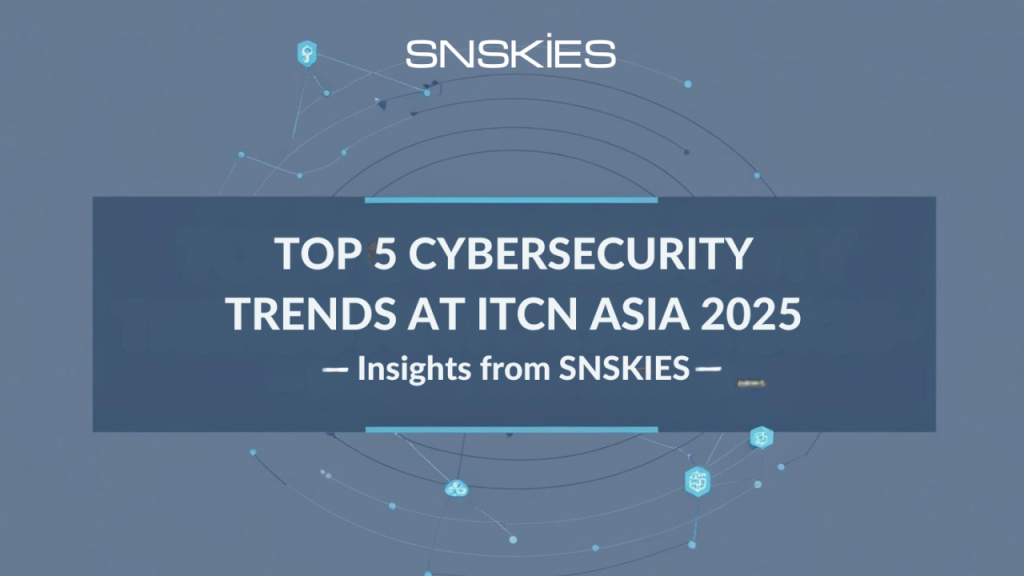
Uncategorized Top 5 Cybersecurity Trends to Watch at ITCN ASIA 2025 – Insights from SNSKIES Uncategorized Top 5 Cybersecurity Trends to Watch at ITCN ASIA 2025 – Insights from SNSKIES Uncategorized April 29, 2025 As organizations across Asia accelerate their digital transformation, the annual ITCN ASIA 2025 exhibition stands out as the premier showcase for cutting-edge cybersecurity solutions. From MSSP Cybersecurity and Managed SOC offerings to the evolving conversation on cybersecurity vs network security, SNSKIES is proud to present its latest innovations. In this article, we dive into the top five trends to watch at ITCN ASIA 2025, complete with real-world examples, data-backed insights from snskies.com, and links to downloadable resources to help you stay ahead of emerging threats. 1. MSSP Cybersecurity: Proactive Defense at Scale Trend Overview Managed Security Service Providers (MSSPs) have evolved into full-spectrum defense providers that combine automated detection with expert analysis. In 2025, MSSP Cybersecurity will emphasize threat hunting, behavioral analytics, and automated response playbooks capable of adapting to complex attack patterns. Key Insights Organizations leveraging MSSP Cybersecurity report up to a 40% reduction in incident dwell time. Integration of AI-driven anomaly detection with human validation ensures balanced accuracy and responsiveness. SNSKIES Spotlight At ITCN ASIA 2025, SNSKIES will demonstrate its flagship MSSP platform, which integrates seamless AI-model updates with streamlined incident escalation processes for cost-effective, 24/7 protection. 2. Managed SOC: Turnkey Security Operations Why It Matters A Managed SOC (Security Operations Center) provides a turnkey approach to security monitoring, incident response, and forensic analysis. By leveraging advanced SIEM tools and continuous threat intelligence, Managed SOC services bring enterprise-grade capabilities within reach of businesses of all sizes. Core Components Real-time log aggregation and correlation Automated playbooks for rapid threat containment Continuous incident triage with detailed reporting On-site Experience SNSKIES at ITCN ASIA 2025 to experience a live SOC war room simulation, highlighting how Managed SOC services can neutralize a simulated ransomware incident in under five minutes. 3. Cloud Security: Protecting Hybrid Environments Market Shift As workloads migrate to public and hybrid clouds, securing these dynamic environments is more critical than ever. Key focus areas for 2025 include: Container and Kubernetes hardening Cloud Workload Protection Platforms (CWPP) Cloud-native Application Security Testing (AST) SNSKIES Solution CloudGuard X automatically profiles cloud workloads, detects misconfigurations, and orchestrates remediation workflows through an intuitive dashboard—reducing manual overhead and tightening security postures. 4. Zero Trust Architecture: Continuous Verification Core Principle Zero Trust shifts security from perimeter-based controls to identity-centric, continuous verification. At ITCN ASIA 2025, expect demonstrations of: Adaptive access control based on real-time risk scoring Micro-segmentation across on-premises and cloud infrastructure Continuous authentication using behavioral analytics Implementation in FocusSNSKIES will preview TrustSphere, a policy-driven engine that adjusts access dynamically based on device posture, location, and usage patterns—ensuring least-privilege access at all times. 5. Cybersecurity vs Network Security: Understanding the Difference Clarifying the Debate While network security focuses on protecting infrastructure components like firewalls and VPNs, cybersecurity encompasses a broader set of defenses for applications, data, and identities. Aspect Network Security Cybersecurity Scope Internal network infrastructure All digital assets, including cloud services and apps Primary Focus Packet filtering, segmentation, perimeter control Endpoint protection, data integrity, identity management Key Technologies Firewalls, IDS/IPS, VPNs IAM, encryption, threat intelligence Strategic Alignment A comprehensive security program integrates both disciplines. At ITCN ASIA 2025, SNSKIES will host an interactive session on aligning network security measures with broader cybersecurity strategies to defend evolving attack surfaces. In a landscape increasingly shaped by digital innovation and emerging threats, understanding the nuanced differences between cyber security and network security is vital for organizations aiming to safeguard critical infrastructure, ensure business continuity, and maintain regulatory compliance. At SNSKIES FZ LLC, we help forward-thinking enterprises move beyond siloed thinking to implement a holistic security architecture—one that aligns both disciplines under a unified risk management framework. Defining Network Security Network security refers to the framework of technologies, protocols, and administrative controls used to protect an organization’s internal network infrastructure from unauthorized access, misuse, or compromise. Its core objectives include: Ensuring secure data transmission within internal systems Preventing unauthorized access to network assets Safeguarding endpoints, servers, routers, and communication layers Solutions typically include firewalls, intrusion prevention systems (IPS), network access control (NAC), and virtual private networks (VPNs). These form the foundation upon which a secure IT environment is built. Defining Cyber Security Cyber security encompasses a broader, strategic scope. While it includes network security, it extends protection across digital systems, cloud environments, software applications, data assets, user identities, and more. A mature cyber security program protects against a wide array of risks, such as: Sophisticated cyber attacks (e.g., ransomware, APTs, phishing) Insider threats and credential abuse Data exfiltration and intellectual property theft Compliance violations and reputational damage At SNSKIES FZ LLC, our approach to cyber security integrates governance, risk management, and technical controls to deliver a comprehensive defense model. Cyber Security vs Network Security: Key Differentiators Cyber Security vs Network Security: Key Differentiators Addressing Network-Level Vulnerabilities Despite advanced tools, many breaches still originate from overlooked weaknesses within the network. Common issues include: Misconfigured devices and unpatched systems Unsecured endpoints and BYOD vulnerabilities Excessive administrative privileges Lack of proper segmentation and access controls Insider threats—both intentional and inadvertent At SNSKIES FZ LLC, our risk assessments frequently reveal such vulnerabilities during pre-engagement audits. Early detection and remediation are essential to hardening network defenses. Enhancing Network Security Through Artificial Intelligence AI and machine learning have become pivotal in modern network defense strategies. By applying behavioral analytics and real-time threat modeling, AI improves visibility, accelerates response times, and enhances threat detection accuracy. Benefits include: Rapid anomaly detection and response automation Reduced dwell time of undetected threats Scalable monitoring across hybrid IT environments SNSKIES FZ LLC integrates AI-driven threat detection into client environments to proactively manage risk at scale. Best Practices in Enterprise Network Security An effective network security strategy must be proactive, resilient, and adaptable. At SNSKIES FZ LLC, we guide clients in adopting industry best practices, including: Routine patching and infrastructure updates Role-based access control (RBAC) and least-privilege principles Segmentation
The Evolution of ITCN: How SNSKIES Is Advancing the Future of IT and Telecom in Pakistan at ITCN Asia Lahore 2025

Articles Advanced Threat Protection for Modern Businesses | SNSKIES FZ LLC Articles Advanced Threat Protection for Modern Businesses | SNSKIES FZ LLC Articles April 9, 2025 As Pakistan accelerates its journey toward a digitally integrated economy, key players in the IT and telecom sectors are stepping forward to drive innovation, security, and growth. Among these leaders is SNSKIES, a premier provider of managed IT services, now partnering with Fortinet, a global authority in cybersecurity. Set to take place from May 9th to 11th, 2025 at the Expo Centre Lahore, the 26th ITCN ASIA — officially titled ITCN Asia Lahore 2025 — will serve as a critical platform for stakeholders shaping Pakistan’s technological future. SNSKIES will be at the forefront of this transformation, showcasing advanced solutions, engaging with industry leaders, and demonstrating its role in advancing the digital ecosystem. The Evolution of ITCN and Its National Impact For over two decades, ITCN Asia has stood as South Asia’s most influential IT and telecom exhibition, connecting global technology providers with local markets. With each edition, the event has evolved, reflecting the increasing significance of digital transformation in public and private sectors alike. The 26th ITCN ASIA represents a key milestone in this evolution, and SNSKIES is proud to be an active contributor to the event’s growing impact on Pakistan’s ICT landscape. SNSKIES: Driving Business Transformation Through Managed Services Established with a vision to deliver intelligent and secure IT infrastructure solutions, SNSKIES has consistently enabled organizations to scale with agility and confidence. Its managed services portfolio spans: Cloud solutions and infrastructure optimization End-to-end network management Data center architecture and operations 24/7 IT support and remote monitoring Cybersecurity and risk mitigation strategies By aligning technology with business objectives, SNSKIES has become a trusted IT partner for enterprises across diverse industries in Pakistan. Enhancing Cybersecurity Through Strategic Partnership with Fortinet In today’s threat landscape, cybersecurity is a fundamental business priority. Recognizing this need, SNSKIES has partnered with Fortinet, a global leader in broad, integrated, and automated cybersecurity solutions. Through this alliance, SNSKIES delivers Fortinet-powered services that include: Next-Generation Firewalls (NGFWs) with deep threat intelligence Secure SD-WAN solutions to optimize and secure branch connectivity Unified Threat Management (UTM) for comprehensive risk coverage Endpoint Protection using FortiClient and EDR capabilities Zero Trust Network Access (ZTNA) and advanced identity control Security Operations (SOC) and SIEM integration for enterprise resilience Together, SNSKIES and Fortinet provide Pakistani businesses with robust protection and proactive threat management — critical components of a secure digital infrastructure. ITCN Asia Lahore 2025: Why You Should Engage with SNSKIES At the 26th ITCN ASIA, SNSKIES will offer an immersive experience for IT decision-makers and professionals looking to modernize and secure their operations. Visitors to the SNSKIES booth will benefit from: Live demonstrations of Fortinet-integrated solutions Consultations with industry-certified engineers and solution architects Use case presentations from local industries and enterprise clients Expert sessions on the future of managed services and cybersecurity in Pakistan The event presents a valuable opportunity to explore how SNSKIES’ tailored services can support your organization’s digital strategy. Shaping a Digitally Empowered Pakistan As digital transformation becomes a national imperative, SNSKIES remains committed to its role as an enabler of technological advancement. The company’s strategic initiatives, robust service offerings, and global partnerships — such as its alliance with Fortinet — position it as a catalyst for change within Pakistan’s IT sector. Participation in ITCN Asia Lahore 2025 reaffirms this commitment. SNSKIES looks forward to engaging with industry leaders, policymakers, and technology professionals to contribute toward building a smarter, safer, and more connected Pakistan. Recent Post All Posts Articles The Evolution of ITCN: How SNSKIES Is Advancing the Future of IT and Telecom in Pakistan at ITCN Asia Lahore… April 22, 2025/ Cyber vs Network Security: What Businesses Must Know April 15, 2025/ Advanced Threat Protection for Modern Businesses | SNSKIES FZ LLC April 9, 2025/ Older Posts
Cyber vs Network Security: What Businesses Must Know

Articles SMTP & SMTP Server Solutions | Reliable Email Infrastructure – SNSKIES FZ LLC Articles SMTP & SMTP Server Solutions | Reliable Email Infrastructure – SNSKIES FZ LLC Articles April 8, 2025 In a landscape increasingly shaped by digital innovation and emerging threats, understanding the nuanced differences between cyber security and network security is vital for organizations aiming to safeguard critical infrastructure, ensure business continuity, and maintain regulatory compliance. At SNSKIES FZ LLC, we help forward-thinking enterprises move beyond siloed thinking to implement a holistic security architecture—one that aligns both disciplines under a unified risk management framework. Defining Network Security Network security refers to the framework of technologies, protocols, and administrative controls used to protect an organization’s internal network infrastructure from unauthorized access, misuse, or compromise. Its core objectives include: Ensuring secure data transmission within internal systems Preventing unauthorized access to network assets Safeguarding endpoints, servers, routers, and communication layers Solutions typically include firewalls, intrusion prevention systems (IPS), network access control (NAC), and virtual private networks (VPNs). These form the foundation upon which a secure IT environment is built. Defining Cyber Security Cyber security encompasses a broader, strategic scope. While it includes network security, it extends protection across digital systems, cloud environments, software applications, data assets, user identities, and more. A mature cyber security program protects against a wide array of risks, such as: Sophisticated cyber attacks (e.g., ransomware, APTs, phishing) Insider threats and credential abuse Data exfiltration and intellectual property theft Compliance violations and reputational damage At SNSKIES FZ LLC, our approach to cyber security integrates governance, risk management, and technical controls to deliver a comprehensive defense model. Cyber Security vs Network Security: Key Differentiators Cyber Security vs Network Security: Key Differentiators Addressing Network-Level Vulnerabilities Despite advanced tools, many breaches still originate from overlooked weaknesses within the network. Common issues include: Misconfigured devices and unpatched systems Unsecured endpoints and BYOD vulnerabilities Excessive administrative privileges Lack of proper segmentation and access controls Insider threats—both intentional and inadvertent At SNSKIES FZ LLC, our risk assessments frequently reveal such vulnerabilities during pre-engagement audits. Early detection and remediation are essential to hardening network defenses. Enhancing Network Security Through Artificial Intelligence AI and machine learning have become pivotal in modern network defense strategies. By applying behavioral analytics and real-time threat modeling, AI improves visibility, accelerates response times, and enhances threat detection accuracy. Benefits include: Rapid anomaly detection and response automation Reduced dwell time of undetected threats Scalable monitoring across hybrid IT environments SNSKIES FZ LLC integrates AI-driven threat detection into client environments to proactively manage risk at scale. Best Practices in Enterprise Network Security An effective network security strategy must be proactive, resilient, and adaptable. At SNSKIES FZ LLC, we guide clients in adopting industry best practices, including: Routine patching and infrastructure updates Role-based access control (RBAC) and least-privilege principles Segmentation of critical network zones Data encryption both in transit and at rest Third-party penetration testing and compliance audits Security awareness training for employees and stakeholders Incident response planning and tabletop simulations The Business Imperative for Cyber Security Cyber security is not merely an IT function—it is a board-level priority. The potential consequences of cyber incidents—regulatory penalties, reputational harm, financial losses, and business interruption—demand strategic attention and long-term investment. SNSKIES FZ LLC helps organizations navigate: Evolving global compliance frameworks (e.g., GDPR, ISO 27001, NIST) Secure digital transformation initiatives Zero-trust security models Cloud-native security architectures Business continuity and disaster recovery strategies We work closely with enterprise leaders to build security programs that are agile, scalable, and future-ready. The CIA Triad: Foundation of Information Security The Confidentiality, Integrity, and Availability (CIA) Triad is a universally accepted model guiding both cyber and network security strategies. Confidentiality: Ensuring access is restricted to authorized personnel Integrity: Guaranteeing that data is accurate, complete, and unaltered Availability: Ensuring that systems and data remain accessible when needed At SNSKIES FZ LLC, the CIA Triad informs all aspects of our security architecture and policy development services. Conclusion: Building Unified, Adaptive Security Postures Organizations must move beyond the simplistic lens of cyber security vs network security. Instead, they should adopt an integrated security model that recognizes network security as an essential component of a larger, enterprise-wide cyber security strategy. By partnering with SNSKIES FZ LLC, businesses gain access to security expertise, frameworks, and technologies that not only mitigate risk—but also create competitive advantage through digital trust, resilience, and compliance readiness. Recent Post All Posts Articles Cyber vs Network Security: What Businesses Must Know April 15, 2025/ Advanced Threat Protection for Modern Businesses | SNSKIES FZ LLC April 9, 2025/ SMTP & SMTP Server Solutions | Reliable Email Infrastructure – SNSKIES FZ LLC April 8, 2025/ Older Posts